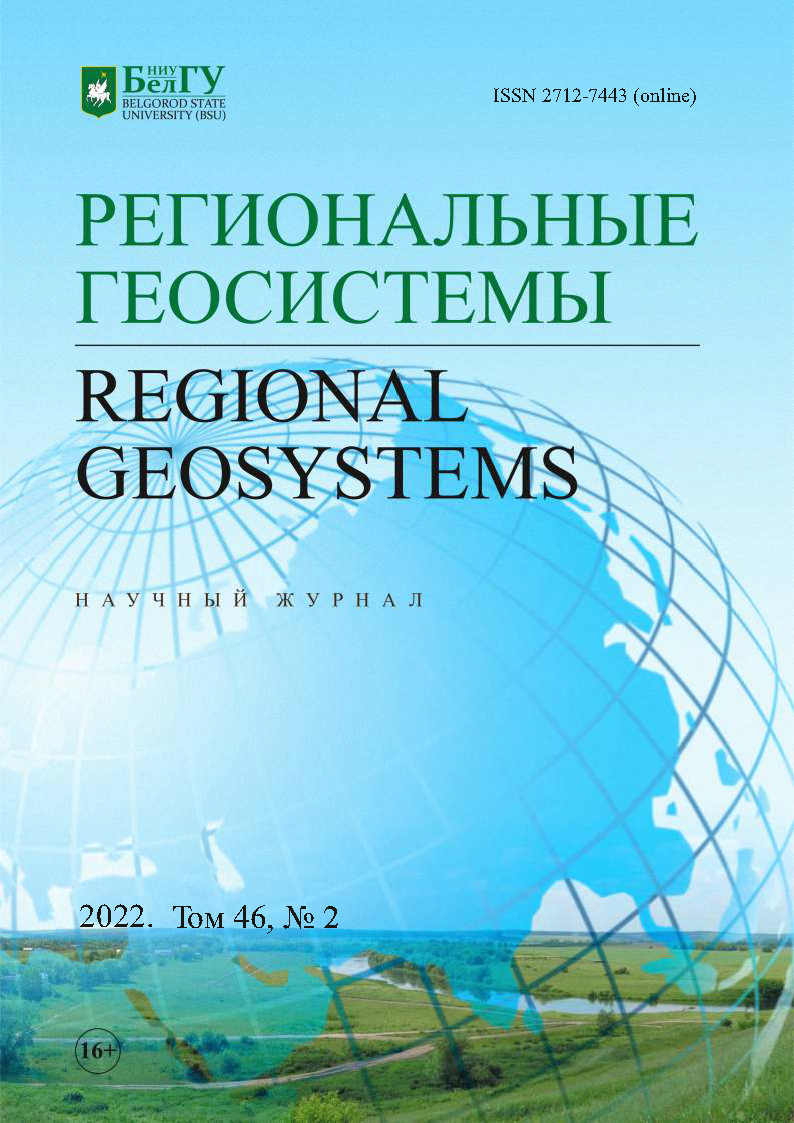Synthesis and Dissemination of Spatial Data on Metageosystems for Information Support of Management Decisions
DOI:
https://doi.org/10.52575/2712-7443-2022-46-2-241-253Keywords:
metageosystems, spatial data, geoportals, machine learning, sustainable developmentAbstract
The article analyzes and systematizes domestic and international experience in the design, verification, updating and practical use of digital spatial data infrastructure for the purposes of harmonizing the interaction of natural, social and industrial subsystems, sustainable development of territories. The characteristic of the existing international, state, regional, local geoportal systems providing synthesis, structuring, visualization and dissemination of spatially distributed data on metageosystems for information support of management decisions in the field of sustainable ecological, social and economic development is given in order to substantiate an effective conceptual model of problematic-oriented geoportal system. Systems of this class, based on the layers of a spatial database obtained by processing cartographic materials, remote sensing data, field studies, serve as a tool for visualizing and disseminating spatial data on metageosystems, studying the relationship and dependence between natural, social and industrial processes and phenomena, provide an opportunity develop recommendations for optimizing the processes of economic development of landscapes.
Acknowledgements. The research was supported by RSF (project No. 22-27-00651).
Downloads
References
Кошкарев А.В. 2019. Геоинформатика в инфраструктурном обеспечении цифровой экономики. Геодезия и картография, 80 (1): 119–126. DOI: 10.22389/0016-7126-2019-943-1-119-126.
Николаев В.А. 1978. Классификация и мелкомасштабное картографирование ландшафтов. М., Изд-во Московского университета, 62 с.
Сочава Б.В. 1978. Введение в учение о геосистемах. Новосибирск, Наука, 319 с.
Azarang A., Manoochehri H.E., Kehtarnavaz N. 2019. Convolutional Autoencoder-Based Multispectral Image Fusion. IEEE Access, 7: 35673–35683. DOI: 10.1109/ACCESS.2019.2905511.
Candela L., Castelli D., Pagan P. 2018. Managing Big Data through Hybrid Data Infrastructures. ERCIM News, 89: 37–38.
Chen Q., Song X., Yamada H. 2016. Learning Deep Representation from Big and Heterogeneous Data for Traffic Accident Inference. Proceedings of the AAAI Conference on Artificial Intelligence, 30 (1): 338–344.
Heaton J., Datta A., Finley A.O. 2019. A Case Study Competition Among Methods for Analyzing Large Spatial Data. Journal of Agricultural, Biological and Environmental Statistics, 24 (3): 398–425. DOI: 10.1007/s13253-018-00348-w.
Ienco D., Gaetano R., Dupaquier C. 2017. Land Cover Classification Via Multitemporal Spatial Data by Deep Recurrent Neural Networks. IEEE Geoscience and Remote Sensing Letters, 14 (10): 1685–1689. DOI: 10.1109/LGRS.2017.2728698.
Kong Y.L., Huang Q., Wang C. 2018. Long Short-Term Memory Neural Networks for Online Disturbance Detection in Satellite Image Time Series. Remote Sensing, 10 (3): 452. DOI: 10.3390/rs10030452.
Kussul N., Lavreniuk M., Skakun S. 2017. Deep Learning Classification of Land Cover and Crop Types Using Remote Sensing Data. IEEE Geoscience and Remote Sensing Letters, 14 (5): 778–782. DOI: 10.1109/LGRS.2017.2681128.
Landgrebe D.A. 2003. Signal Theory Methods in Multispectral Remote Sensing. New Jersey, Wiley, 508 р. DOI:10.1002/0471723800.
LeCun Y., Bengio Y., Hinton G. 2015. Deep Learning. Nature, 521: 436–444. DOI: 10.1038/nature14539.
Lee J., Kang M. 2015. Geospatial Big Data: Challenges and Opportunities. Big Data Research, 2 (2): 74–81. DOI: 10.1016/j.bdr.2015.01.003.
Li M., Guo W., Duan L., Zhu X. 2017. A Case-Based Reasoning Approach for Task-Driven Spatial-Temporally Aware Geospatial Data Discovery Through Geoportals. International Journal of Digital Earth, 10 (11): 1146–1165. DOI: 10.1080/17538947.2017.1285968.
Liu Y., Racah E., Correa J., Khosrowshahi A., Lavers D., Kunkel K., Wehner M., Collins W. 2016. Application of Deep Convolutional Neural Networks for Detecting Extreme Weather in Climate Datasets. arXiv preprint: 1605.01156. DOI: 10.48550/arXiv.1605.01156.
Lü G., Batty M., Strobl J. 2019. Reflections and Speculations on the Progress in Geographic Information Systems (GIS): a Geographic Perspective. International journal of geographical information science, 33 (2): 346–367. DOI: 10.1080/13658816.2018.1533136.
Mohan A., Singh A.K., Kumar B., Dwivedi R. 2021. Review on Remote Sensing Methods for Landslide Detection Using Machine and Deep Learning. Transactions on Emerging Telecommunications Technologies, 32 (7): e3998. DOI: 10.1002/ett.3998.
Rajabifard A., Feeney M.E., Williamson I.P. 2002. Future Directions for SDI Development. International Journal of Applied Earth Observation and Geoinformation, 4 (1): 11–22. DOI: 10.1016/S0303-2434(02)00002-8.
Yamashkin A.A., Yamashkin S.A., Aksyonova M.Yu. 2020a. Cultural Landscapes Space-Temporal Systematization of Information in Geoportals for the Purposes of Region Tourist and Recreational Development. Geojournal of Tourism and Geosites, 29 (2): 440–449. DOI 10.30892/gtg.29205-480.
Yamashkin S.A., Yamashkin A.A., Zanozin V.V. 2020b. Improving the Efficiency of Deep Learning Methods in Remote Sensing Data Analysis: Geosystem Approach. IEEE Access, 8: 179516–179529. DOI: 10.1109/ACCESS.2020.3028030.
Yuan X., Shi J., Gu L. 2021. A Review of Deep Learning Methods for Semantic Segmentation of Remote Sensing Imagery. Expert Systems with Applications, 169: 114417. DOI: 10.1016/j.eswa.2020.114417.
Abstract views: 205
Share
Published
How to Cite
Issue
Section
Copyright (c) 2022 REGIONAL GEOSYSTEMS

This work is licensed under a Creative Commons Attribution 4.0 International License.


